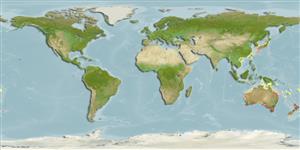>
Centrarchiformes (Basses) >
Microcanthidae (Stripeys)
Etymology: Atypichthys: Greek, atypus = not following the rules + Greek, ichthys = fish; perhaps a strange species.
More on author: Günther.
Environment: milieu / climate zone / depth range / distribution range
Ecología
marino; salobre asociado a arrecife. Subtropical
Indo-West Pacific: southeastern Australia.
Tamaño / Peso / Age
Maturity: Lm ? range ? - ? cm
Max length : 25.0 cm TL macho / no sexado; (Ref. 9002); common length : 18.0 cm TL macho / no sexado; (Ref. 9002)
A schooling species, particularly common on coastal reefs in southern New South Wales (Ref. 9002). Also commonly found under jetties in harbors and large estuaries (Ref. 9002).
Life cycle and mating behavior
Madurez | Reproducción | Puesta | Huevos | Fecundidad | Larva
Kuiter, R.H., 1993. Coastal fishes of south-eastern Australia. University of Hawaii Press. Honolulu, Hawaii. 437 p. (Ref. 9002)
IUCN Red List Status (Ref. 130435)
Threat to humans
Harmless
Human uses
Más información
Nombres comunesSinónimosMetabolismoDespredadoresEcotoxicologíaReproducciónMadurezPuestaAgregación para la puestaFecundidadHuevosEgg development
ReferenciasAcuiculturaPerfil de acuiculturaRazasGenéticaElectrophoresesheritabilidadEnfermedadesProcesamientoNutrientsMass conversion
ColaboradoresImágenesStamps, Coins Misc.SonidosCiguateraVelocidadTipo de nataciónSuperficie branquialOtolitosCerebrosVisión
Herramientas
Special reports
Download XML
Fuentes de Internet
Estimates based on models
Preferred temperature (Ref.
123201): 15.3 - 25, mean 18.5 °C (based on 406 cells).
Phylogenetic diversity index (Ref.
82804): PD
50 = 0.7500 [Uniqueness, from 0.5 = low to 2.0 = high].
Bayesian length-weight: a=0.02291 (0.00896 - 0.05857), b=2.99 (2.77 - 3.21), in cm total length, based on LWR estimates for this (Sub)family-body shape (Ref.
93245).
Nivel trófico (Ref.
69278): 3.4 ±0.4 se; based on size and trophs of closest relatives
Fishing Vulnerability (Ref.
59153): Low vulnerability (15 of 100).
Nutrients (Ref.
124155): Calcium = 45.7 [19.6, 80.8] mg/100g; Iron = 0.638 [0.361, 1.173] mg/100g; Protein = 19.1 [17.9, 20.3] %; Omega3 = 0.16 [0.09, 0.29] g/100g; Selenium = 13.5 [5.8, 30.0] μg/100g; VitaminA = 30.8 [7.1, 132.1] μg/100g; Zinc = 1.17 [0.74, 1.95] mg/100g (wet weight);
